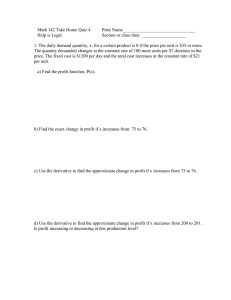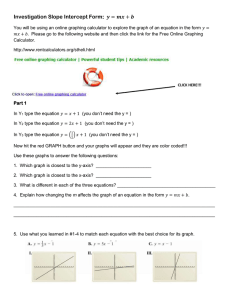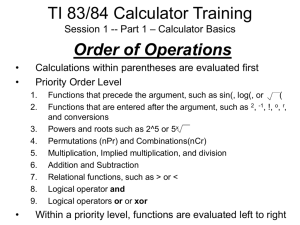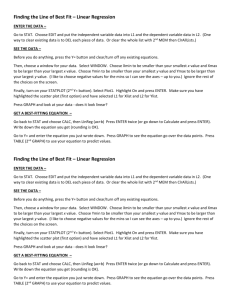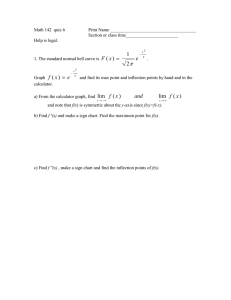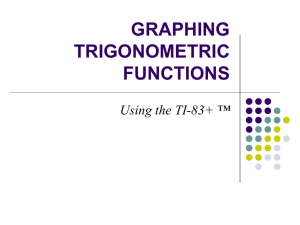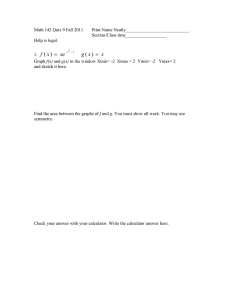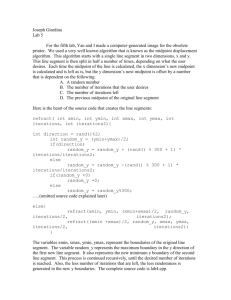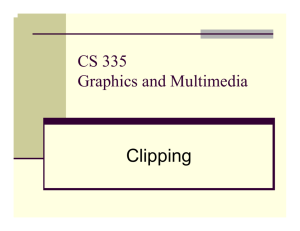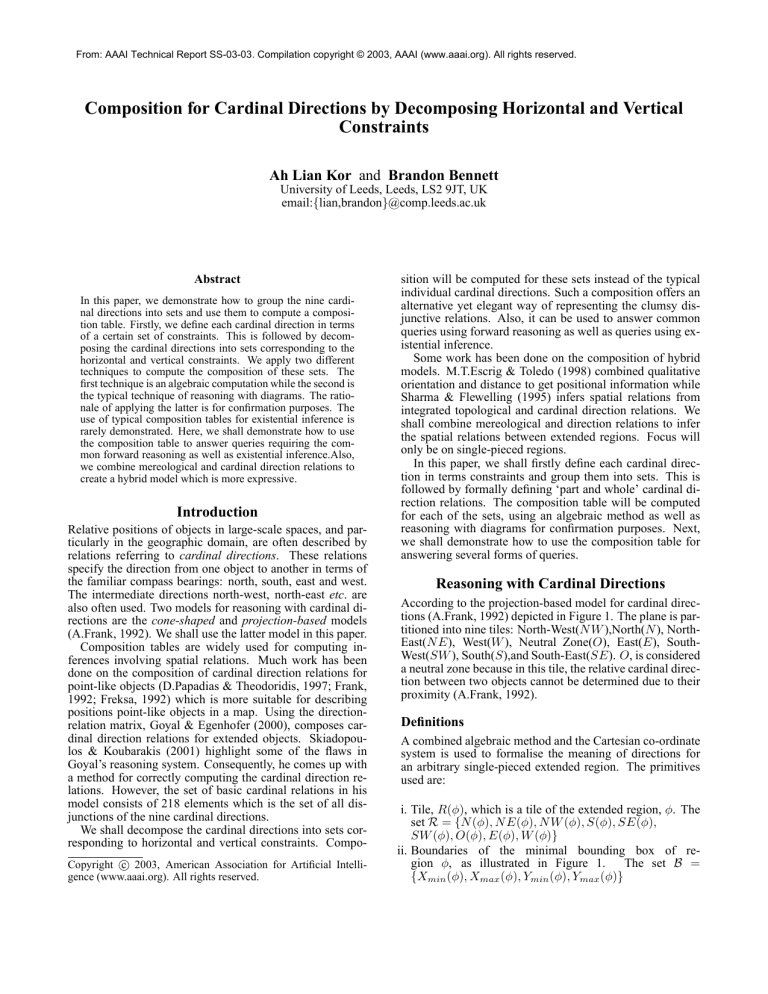
From: AAAI Technical Report SS-03-03. Compilation copyright © 2003, AAAI (www.aaai.org). All rights reserved.
Composition for Cardinal Directions by Decomposing Horizontal and Vertical
Constraints
Ah Lian Kor and Brandon Bennett
University of Leeds, Leeds, LS2 9JT, UK
email:{lian,brandon}@comp.leeds.ac.uk
Abstract
In this paper, we demonstrate how to group the nine cardinal directions into sets and use them to compute a composition table. Firstly, we define each cardinal direction in terms
of a certain set of constraints. This is followed by decomposing the cardinal directions into sets corresponding to the
horizontal and vertical constraints. We apply two different
techniques to compute the composition of these sets. The
first technique is an algebraic computation while the second is
the typical technique of reasoning with diagrams. The rationale of applying the latter is for confirmation purposes. The
use of typical composition tables for existential inference is
rarely demonstrated. Here, we shall demonstrate how to use
the composition table to answer queries requiring the common forward reasoning as well as existential inference.Also,
we combine mereological and cardinal direction relations to
create a hybrid model which is more expressive.
Introduction
Relative positions of objects in large-scale spaces, and particularly in the geographic domain, are often described by
relations referring to cardinal directions. These relations
specify the direction from one object to another in terms of
the familiar compass bearings: north, south, east and west.
The intermediate directions north-west, north-east etc. are
also often used. Two models for reasoning with cardinal directions are the cone-shaped and projection-based models
(A.Frank, 1992). We shall use the latter model in this paper.
Composition tables are widely used for computing inferences involving spatial relations. Much work has been
done on the composition of cardinal direction relations for
point-like objects (D.Papadias & Theodoridis, 1997; Frank,
1992; Freksa, 1992) which is more suitable for describing
positions point-like objects in a map. Using the directionrelation matrix, Goyal & Egenhofer (2000), composes cardinal direction relations for extended objects. Skiadopoulos & Koubarakis (2001) highlight some of the flaws in
Goyal’s reasoning system. Consequently, he comes up with
a method for correctly computing the cardinal direction relations. However, the set of basic cardinal relations in his
model consists of 218 elements which is the set of all disjunctions of the nine cardinal directions.
We shall decompose the cardinal directions into sets corresponding to horizontal and vertical constraints. CompoCopyright c 2003, American Association for Artificial Intelligence (www.aaai.org). All rights reserved.
sition will be computed for these sets instead of the typical
individual cardinal directions. Such a composition offers an
alternative yet elegant way of representing the clumsy disjunctive relations. Also, it can be used to answer common
queries using forward reasoning as well as queries using existential inference.
Some work has been done on the composition of hybrid
models. M.T.Escrig & Toledo (1998) combined qualitative
orientation and distance to get positional information while
Sharma & Flewelling (1995) infers spatial relations from
integrated topological and cardinal direction relations. We
shall combine mereological and direction relations to infer
the spatial relations between extended regions. Focus will
only be on single-pieced regions.
In this paper, we shall firstly define each cardinal direction in terms constraints and group them into sets. This is
followed by formally defining ‘part and whole’ cardinal direction relations. The composition table will be computed
for each of the sets, using an algebraic method as well as
reasoning with diagrams for confirmation purposes. Next,
we shall demonstrate how to use the composition table for
answering several forms of queries.
Reasoning with Cardinal Directions
According to the projection-based model for cardinal directions (A.Frank, 1992) depicted in Figure 1. The plane is partitioned into nine tiles: North-West(N W ),North(N ), NorthEast(N E), West(W ), Neutral Zone(O), East(E), SouthWest(SW ), South(S),and South-East(SE). O, is considered
a neutral zone because in this tile, the relative cardinal direction between two objects cannot be determined due to their
proximity (A.Frank, 1992).
Definitions
A combined algebraic method and the Cartesian co-ordinate
system is used to formalise the meaning of directions for
an arbitrary single-pieced extended region. The primitives
used are:
i. Tile, R(φ), which is a tile of the extended region, φ. The
set R = {N (φ), N E(φ), N W (φ), S(φ), SE(φ),
SW (φ), O(φ), E(φ), W (φ)}
ii. Boundaries of the minimal bounding box of region φ, as illustrated in Figure 1. The set B =
{Xmin (φ), Xmax (φ), Ymin (φ), Ymax (φ)}
Figure 1: Boundaries
For an arbitrary extended region, φ, with a minimal bounding box, the two implicit constraints are:
Xmin (φ) < Xmax (φ)
Ymin (φ) < Ymax (φ)
Next, we shall define all the nine tiles in terms of the
boundaries of the minimal bounding box of extended region
φ.
• N (φ) = {hx, yi|Xmin (φ) ≤ x ≤ Xmax (φ) ∧ y ≥
Ymax (φ)}
• N E(φ) = {hx, yi|x ≥ Xmax (φ) ∧ y ≥ Ymax (φ)}
• N W (φ) = {hx, yi|x ≤ Xmin (φ) ∧ y ≥ Ymax (φ)}
• S(φ) = {hx, yi|Xmin (φ) ≤ x ≤ Xmax (φ) ∧ y ≤
Ymin (φ)}
• SE(φ) = {hx, yi|x ≥ Xmax (φ) ∧ y ≤ Ymin (φ)}
• SW (φ) = {hx, yi|x ≤ Xmin (φ) ∧ y ≤ Ymin (φ)}
• E(φ) = {hx, yi|x ≥ Xmax (φ) ∧ Ymin (φ) ≤ y ≤
Ymax (φ)}
• W (φ) = {hx, yi|x ≤ Xmin (φ) ∧ Ymin (φ) ≤ y ≤
Ymax (φ)}
• O(φ) = {hx, yi|Xmin (φ) ≤ x ≤ Xmax (φ) ∧ Ymin (φ) ≤
y ≤ Ymax (φ)}
Notations
The composition of two relations, R and S, is written as
(R; S) It is defined by the following equivalence:
∀xz[(R; S)xz ←→ ∃y[Rxy ∧ Syz]]
Horizontal and Vertical Constraints
Horizontal Constraints
For the horizontal sets, the range of values for y remains
constant while the values for x change either in an ascending
or descending order. As shown in Figure 2, the three horizontal sets of tiles for the region φ are: (N W (φ) ∪ N (φ) ∪
N E(φ)), (W (φ) ∪ O(φ) ∪ E(φ)), and (SW (φ) ∪ S(φ) ∪
SE(φ)).
If there is a referent region a, and another arbitrary region,
b, the possible horizontal sets of binary relations and their
constraints can be written as follows:
Figure 2: Sets of tiles
• If b ⊆ (N W (a) ∪ N (a) ∪ N E(a)) then
N ab = {N W(a, b), N (a, b), N E(a, b)},
and the constraints are: Ymax (a) ≤ Ymin (b)∧Ymax (a) <
Ymax (b).
• If b ⊆ (W (a) ∪ O(a) ∪ E(a)) then
Hab = {W(a, b), O(a, b), E(a, b)},
and the constraints are: Ymax (a) ≥ Ymax (b)∧Ymin (a) <
Ymax (b) ∧ Ymin (a) ≤ Ymin (b) ∧ Ymax (a) > Ymin (b).
• If b ⊆ (SW (a) ∪ S(a) ∪ SE(a)) then
Sab = {SW(a, b), S(a, b), SE(a, b)},
and the constraints are: Ymin (a) ≥ Ymax (b)∧Ymin (a) >
Ymin (b).
Vertical Constraints
As for the vertical sets, the range of values for x remains
constant while the values for y change either in an ascending
or descending order. The vertical sets of tiles for the region
φ are: (N E(φ) ∪ E(φ) ∪ SE(φ)), (N (φ) ∪ O(φ) ∪ S(φ)),
and (N W (φ) ∪ W (φ) ∪ SW (φ)).
The possible vertical sets of binary relations and their constraints can be written as follows:
• If b ⊆ (N E(a) ∪ E(a) ∪ SE(a)) then
Eab = {SE(a, b), E(a, b), N E(a, b)},
and the constraints are: Xmax (a) ≤
Xmax (a) < Xmax (b).
Xmin (b) ∧
• If b ⊆ (N (a) ∪ O(a) ∪ S(a)) then
Vab = {S(a, b), O(a, b), N (a, b)},
and the constraints are: Xmax (a) ≥ Xmax (b) ∧
Xmin (a) < Xmax (b) ∧ Xmin (a) ≤ Xmin (b) ∧
Xmax (a) > Xmin (b).
• If b ⊆ (N W (a) ∪ W (a) ∪ SW (a)) then
Wab = {SW(a, b), W(a, b), N W(a, b)},
the constraints are: Xmin (a) ≥ Xmax (b) ∧ Xmin (a) >
Xmin (b).
Combined Mereological and Cardinal
Direction Relations
In this section, we shall make a distinction between part and
whole direction relations between two extended regions. A
direction relation PR (a, b) means that only part of the destination extended region, b, is in tile R(a). The direction
relation AR (a, b) is used when the whole of region, b, is
completely within the tile R(a).
For example, if b is completely North of a, this direction
relation can be represented as below:
AN (a, b) = PN (a, b) ∧ ¬PN E (a, b) ∧
PN W (a, b) ∧ ¬PS (a, b) ∧ ¬PSE (a, b)
∧¬PSW (a, b) ∧ ¬PE (a, b) ∧
¬PW (a, b) ∧ ¬PO (a, b)
We shall define the ‘whole’ direction relations in terms of
the sets followed by a set of constraints.
Table 1: Composition of binary ordered relations
b<c b=c b>c
a < b a < c a < c a>c
a=b a<c a=c a>c
a > b a>c a > c a > c
In this section, we shall compute two separate composition tables. One is for the horizontal sets (Table 2) while the
other is for the vertical (Table 3) sets. We shall employ two
different techniques to compute the tables. The first typical technique is reasoning with diagrams. As for the second
technique, it uses algebra and the composition table in Table
1.
Technique 1: Reasoning with a diagram
R(a, b) ∧ S(b, c) where R(a, b) ∈ N ab, and S(b, c) ∈ N bc.
• AN (a, b) ≡ N ab ∩ Vab
[Ymax (a) ≤ Ymin (b) ∧ Ymax (a) < Ymax (b)]∧
[Xmax (a) ≥ Xmax (b) ∧ Xmin (a) < Xmax (b)
∧ Xmin (a) ≤ Xmin (b) ∧ Xmax (a) > Xmin (b)]
• AN E (a, b) ≡ N ab ∩ Eab
[Ymax (a) ≤ Ymin (b) ∧ Ymax (a) < Ymax (b)]∧
[Xmax (a) ≤ Xmin (b) ∧ Xmax (a) < Xmax (b)]
• AN W (a, b) ≡ N ab ∩ Wab
[Ymax (a) ≤ Ymin (b) ∧ Ymax (a) < Ymax (b)]∧
[Xmin (a) ≥ Xmax (b) ∧ Xmin (a) > Xmin (b)]
• AS (a, b) ≡ Sab ∩ Vab
[Ymin (a) ≥ Ymax (b) ∧ Ymin (a) > Ymin (b)]∧
[Xmax (a) ≥ Xmax (b) ∧ Xmin (a) < Xmax (b)
∧ Xmin (a) ≤ Xmin (b) ∧ Xmax (a) > Xmin (b)]
Figure 3: Composition of sets of relations N ab and N bc
• ASE (a, b) ≡ Sab ∩ Eab
[Ymin (a) ≥ Ymax (b) ∧ Ymin (a) > Ymin (b)]∧
[Xmax (a) ≤ Xmin (b) ∧ Xmax (a) < Xmax (b)]
The inequalities that can be derived from Figure 3 are as
follows:
• ASW (a, b) ≡ Sab ∩ Wab
[Ymin (a) ≥ Ymax (b) ∧ Ymin (a) > Ymin (b)]∧
[Xmin (a) ≥ Xmax (b) ∧ Xmin (a) > Xmin (b)]
• AE (a, b) ≡ Hab ∩ Eab
[Ymax (a) ≥ Ymax (b) ∧ Ymin (a) < Ymax (b)
∧ Ymin (a) ≤ Ymin (b) ∧ Ymax (a) > Ymin (b)]
∧[Xmax (a) ≤ Xmin (b) ∧ Xmax (a) < Xmax (b)]
• AW (a, b) ≡ Hab ∩ Wab
[Ymax (a) ≥ Ymax (b) ∧ Ymin (a) < Ymax (b)
∧ Ymin (a) ≤ Ymin (b) ∧ Ymax (a) > Ymin (b)]
∧[Xmin (a) ≥ Xmax (b) ∧ Xmin (a) > Xmin (b)]
• AO (a, b) ≡ Hab ∩ Vab
[Ymax (a) ≥ Ymax (b) ∧ Ymin (a) < Ymax (b)
∧ Ymin (a) ≤ Ymin (b) ∧ Ymax (a) > Ymin (b)]
∧[Xmax (a) ≥ Xmax (b) ∧ Xmin (a) < Xmax (b)
∧ Xmin (a) ≤ Xmin (b) ∧ Xmax (a) > Xmin (b)]
Computation of the Composition Table
The outcome of the composition of general ordered binary
relations is shown in Table 1.
Ymax (a) ≤ Ymin (b)
(1)
Ymax (b) ≤ Ymin (c)
(2)
Ymax (b) > Ymin (b)
(3)
By default,
By substituting inequality (3) into inequality (2), we get inequality (4).
Ymin (b) < Ymin (c)
(4)
By combining inequalities (1) and (4), we get the relation
Ymax (a) < Ymin (c)
(5)
Substitute this inequality Ymax (a) < Ymax (c) into inequality (5), and we get another relation,
Ymax (a) < Ymax (c)
The solution is:
Ymax (a) < Ymin (c) ∧ Ymax (a) < Ymax (c)
(6)
Technique 2: An algebraic computation
Use the composition table in Table 1 to compute the following composition:
R(a, b) ∧ S(b, c)
where R(a, b) ∈ N ab, and S(b, c) ∈ N bc
We shall represent the above as:
N ab ∧ N bc
By using the sets of constraints listed earlier, we transform
the composition into the following algebraic expression:
[(Ymax (a) ≤ Ymin (b) ∧ (Ymax (a) < Ymax (b)]∧
[(Ymax (b) ≤ Ymin (c) ∧ (Ymax (b) < Ymax (c)]
Substitute the following into the above composition:
Ymax (a) with a,
Ymin (b) with b1 ,
Ymax (b) with b2 ,
Ymin (c) with c1 ,
Ymax (c) with c2 .
We will now have the form:
[(a ≤ b1 ) ∧ (a < b2 )]∧
[(b2 ≤ c1 ) ∧ (b2 < c2 )]
Apply the distributive law and we get the following expression (7).
(a ≤ b1 ) ∧ [(b2 ≤ c1 ) ∧ (b2 < c2 )] ∧
(a < b2 ) ∧ [(b2 ≤ c1 ) ∧ (b2 < c2 )] (7)
Part 1 of inequality (7)
(a ≤ b1 ) ∧ [(b2 ≤ c1 ) ∧ (b2 < c2 )]
= [(a ≤ b1 ) ∧ (b2 ≤ c1 )] ∧ [(a ≤ b1 ) ∧ (b2 < c2 )] (8)
Part 1.1 of inequality (8)
(a ≤ b1 ) ∧ (b2 ≤ c1 )
= [(a < b1 ) ∨ (a = b1 )] ∧ [(b2 < c1 ) ∨ (b2 = c1 )]
= (a < b1 ) ∧ [(b2 < c1 ) ∨ (b2 = c1 )] ∨
(a = b1 ) ∧ [(b2 < c1 ) ∨ (b2 = c1 )]
= (a < b1 ) ∧ (b2 < c1 ) ∨ (a < b1 ) ∧ (b2 = c1 ) ∨
(a = b1 ) ∧ (b2 < c1 ) ∨ (a = b1 ) ∧ (b2 = c1 )
(9)
By default, b2 > b1 , inequality (9) becomes:
(a < b2 ) ∧ (b2 < c1 ) ∨ (a < b2 ) ∧ (b2 = c1 ) ∨
(a < b2 ) ∧ (b2 < c1 ) ∨ (a < b2 ) ∧ (b2 = c1 )
= (a < c1 ) ∨ (a < c1 )
= (a < c1 )
(10)
Part 1.2 of inequality (8)
(a ≤ b1 ) ∧ (b2 < c2 )
= [(a < b1 ) ∧ (a = b1 )] ∧ (b2 < c2 )
= [(a < b1 ) ∧ (b2 < c2 )] ∧ [(a = b1 ) ∧ (b2 < c2 )]
(11)
By default, b2 > b1 , inequality (11) becomes:
[(a < b2 ) ∧ (b2 < c2 )] ∧ [(a < b2 ) ∧ (b2 < c2 )]
= (a < b2 ) ∧ (b2 < c2 )
= (a < c2 )
(12)
Substitute inequalities (10) and (12) into inequality (8), and
we get
(a < c1 ) ∧ (a < c2 )
(13)
Part 2 of the inequality (7)
(a < b2 ) ∧ [(b2 ≤ c1 ) ∧ (b2 < c2 )]
= [(a < b2 ) ∧ (b2 ≤ c1 )] ∧ [(a < b2 ) ∧ (b2 < c2 )]
= (a < b2 ) ∧ [(b2 < c1 ) ∨ (b2 = c1 )]
∧[(a < b2 ) ∧ (b2 < c2 )]
= [(a < c1 ) ∨ (a < c1 )] ∧ (a < c2 )
= (a < c1 ) ∧ (a < c2 ) (14)
Substitute inequalities (13) and (14) into (7), we get
(a < c1 ) ∧ (a < c2 ) ∧ (a < c1 ) ∧ (a < c2 )
= (a < c1 ) ∧ (a < c2 )
= Ymax (a) < Ymin (c) ∧ Ymax (a) < Ymax (c)
(15)
The conclusion is that for the above composition, the
algebraic method yields the same results as the graphical
method.
Composition table
Two composition tables computed for the sets are depicted
in Table 2 and Table 3. The notation N ac∗ in Table 2,
means that it is has the constraints of N ac minus the equality Ymax (a) = Ymin (c). The same goes for Sac∗ in Table 2,
Eac∗ , and Wac∗ in Table 3 . We shall use these composition
tables for forward reasoning as well as existential inference.
Queries for Forward Reasoning
Query 1: AR (a, b) ∧ AR (b, c) Composition
Example 1: Find the composition of AN (a, b) ∧ AN (b, c).
When represented in sets,the above composition can be
rewritten as:
[N ab ∩ Vab] ∧ [N bc ∩ Vbc] = [N ab ∧ N bc] ∧ [Vab ∧ Vbc]
Use composition tables in Table 2, and 3, we get the following outcome:
N ac∗ ∧ Vac
This is equivalent to AN (a, c) with region c disjoint from
the boundary Ymax (a) of the minimum bounding box for
a. This means that the extended region c is disjoint from
extended region a because the region b between them is extended as well. The outcome of this composition concurs
with the model presented by Skiadopoulos & Koubarakis
(2001). However, our result here is more expressive because
it gives us some insight into the topological relationship between a and c as well.
Example 2: Find the following composition:
AN E (a, b) ∧ ASW (b, c)
When represented in sets, the above composition can be
rewritten as:
[N ab ∩ Eab] ∧ [Sbc ∩ Wbc] = [N ab ∧ Sbc] ∧ [Eab ∧ Wbc]
Use composition tables in Table 2, and 3, we get the following outcome:
[N ac ∨ Hac ∨ Sac] ∧ [Eac ∨ Vac ∨ Wac]
The above disjunction implies that the outcome of
the composition includes all tiles and this result is also
consistent with the results presented by Skiadopoulos &
Koubarakis (2001).
Table 2: Composition of horizontal set relations
Note: N ac∗ has the constraints of N ac minus the equality Ymax (a) = Ymin (c)
Sac∗ has the constraints of Sac minus the equality Ymin (a) = Ymax (c)
N bc
Hbc
Sbc
N ab
Ymax (a) < Ymin (c)∧
Ymax (a) < Ymax (c)
N ac∗
Ymax (a) ≤ Ymin (c)∧
Ymax (a) < Ymax (c)
N ac
Ymax (a)>Ymin (c)∧
Ymax (a)>Ymax (c)
N ac ∨ Hac ∨ Sac
Hab
Ymax (a)>Ymin (c)∧
Ymax (a)>Ymax (c)
Ymin (a) < Ymin (c)
N ac ∨ Hac
Ymax (a) ≥ Ymax (c)∧
Ymin (a) ≤ Ymin (c)∧
Ymax (a) > Ymin (c)∧
Ymin (a) < Ymax (c)
Hac
Ymin (a)>Ymin (c)∧
Ymin (a)>Ymin (c)
Ymax (a) > Ymax (c)
Hac ∨ Sac
Sab
Ymax (a)>Ymin (c)∧
Ymax (a)>Ymax (c)
N ac ∨ Hac ∨ Sac
Ymin (a) ≥ Ymax (c)∧
Ymin (a) > Ymin (c)∧
Sac
Ymin (a) > Ymax (c)∧
Ymin (a) > Ymin (c)∧
Sac∗
Table 3: Composition of vertical set relations
Note: Eac∗ has the constraints of Eac minus the equality Xmax (a) = Xmin (c)
Wac∗ has the constraints of Wac minus the equality Xmin (a) = Xmax (c)
Ebc
Vbc
Wbc
Eab
Xmax (a) < Xmin (c)∧
Xmax (a) < Xmax (c)
Eac∗
Xmax (a) ≤ Xmin (c)∧
Xmax (a) < Xmax (c)
Eac
Xmax (a)>Xmin (c)∧
Xmax (a)>Xmax (c)
Eac ∨ Vac ∨ Wac
Vab
Xmax (a)>Xmax (c)∧
Xmax (a)>Xmin (c)
Xmin (a) < Xmin (c)
Eac ∨ Vac
Xmax (a) ≥ Xmax (c)∧
Xmin (a) ≤ Xmin (c)∧
Xmax (a) > Xmin (c)∧
Xmin (a) < Xmax (c)
Vac
Xmin (a)>Xmax (c)∧
Xmin (a)>Xmin (c)
Xmax (a) > Xmax (c)
Vac ∨ Wac
Wab
Xmax (a)>Xmin (c)∧
Xmax (a)>Xmax (c)
Eac ∨ Vac ∨ Wac
Xmin (a) ≥ Xmax (c)∧
Xmin (a) > Xmin (c)∧
Wac
Xmin (a) > Xmax (c)∧
Xmin (a) > Xmin (c)∧
Wac∗
Query 2:
PR (a, b) ∧ AR (b, c) Composition
Find the following composition:
[PN (a, b) ∧ PN E (a, b)] ∧ AN (b, c)
When represented in sets, the above composition can be
rewritten as follows:
[[N ab ∩ Eab] ∪ [N ab ∩ Vab]] ∧ [N bc ∩ Vbc]
= [N ab ∧ N bc] ∧ [[Eab ∧ Vbc] ∨ [Vab ∧ Vbc]]
Use composition tables in Tables 2 and 3, we get the
following outcome:
N ac∗ ∧ [Eac ∨ Vac]
This means that the outcome of the composition is
[PN (a, c) ∧ PN E (a, c)] ∨ AN (a, c) ∨ AN E (a, c) but once
again, with region c disjoint from the boundary Ymax (a) of
the minimum bounding box for a.
Table 5: Query AN (b, c) and PN (a, c) ∧ PN E (a, c)
R1(a, b)
R2(b, c)
R3(a, c)
Queries for Existential Inference
In this section, we shall demonstrate how the composition
tables in Table 2 and 3 can be used to answer queries using
existential inference. This section will also show the outcome of existential inference with certainty and uncertainty.
Query 1: R(a, b) ∧ AR (b, c) = AR (a, c)
If given the constraints for AR (b, c) and (AR (a, c), we have
to find what R(a, b) is.
Example 1:
AN W (a, c).
Find R(a, b) when given AN W (b, c) and
The sets for the relations AN W (b, c) are N bc and Wbc and
AN W (a, c) can be {N ac, N ac∗ } and {Wbc,Wbc∗ } . We
shall tabulate the given information in Table 4.
Table 4: Query for AN W (b, c) and AN W (a, c)
R1(a, b)
R2(b, c)
R3(a, c)
?
N bc
?
Wbc
From Tables 2 and 3
With certainty
N ab
Wab
With uncertainty
Hab
Sab
Vab
Eab
The sets for the relation AN (b, c) are N bc and Vbc.
PN (a, c) are {N ac,N ac∗ } and Vac. PN E (a, c) can be
{N ac, N ac∗ } and Eac. We shall tabulate the given information in Table 5.
N ac∗
N ac
Wac∗
Wac
∗
N bc
Wbc
N ac
Wac∗
N bc
N bc
Wbc
Wbc
N ac ∨ Hac
N ac ∨ Hac ∨ Sac
Vac ∨ Wac
Eac ∨ Vac ∨ Wac
Based on the results in Table 4, with the given constraints
AN W (b, c) and AN W (a, c), R(a, b) is either AN W (a, c) or
[PN W (a, c)∧[PN E (a, c)∨PN (a, c)∨PE (a, c)∨PO (a, c)∨
PW (a, c) ∨ PSE (a, c) ∨ PS (a, c) ∨ PSW (a, c)]]. The latter
relation is subject to the ‘single-piece’ condition. It is true
when the existing parts are connected.
Query 2:
R(a, b) ∧ AR (b, c) = PR (a, c)
If given the constraints for AR (b, c) and PR (a, c), we have
to find what R(a, b) is.
Example 2: Find R(a, b) when given AN (b, c) and
PN (a, c) ∧ PN E (a, c).
?
N bc
?
?
From Tables 2 and 3
With certainty
N ab
Eab
Vab
With uncertainty
Hab
Sab
Vbc
N ac∗
N ac
Eac
Vac
N bc
Vbc
Vbc
N ac∗
Eac
Vac
N bc
N bc
N ac ∨ Hac
N ac ∨ Hac ∨ Sac
Based on the results in Table 5, with the given constraints
AN (b, c) and PN (a, c) ∧ PN E (a, c), the possible outcome
for R(a, b) is either [PN E (a, b)∧PN (a, b)] or [[PN E (a, b)∧
PN (a, b)] ∧ [PN E (a, b) ∨ PO (a, b) ∨ PSE (a, b) ∨ PS (a, b)]].
Query 3:
R(a, b) ∧ PR (b, c) = AR (a, c)
If given the constraints for PR (b, c) and AR (a, c), we have
to find what R(a, b) is.
Example 3: Find R(a, b) when given PW (b, c) ∧
PSW (b, c) ∧ PS (b, c) and ASW (a, c).
The sets for the relation PW (b, c) are Hbc and Wbc,
PSW (b, c) are Sbc and Wbc, and lastly, PS (b, c) are Sbc
and Vbc, As for ASW (a, c), it is Sac and Wac.We shall tabulate the given information in Table 6.
Table 6: Query for PW (b, c) ∧ PSW (b, c) ∧ PS (b, c) and
ASW (a, c)
R1(a, b)
R2(b, c) R3(a, c)
?
?
?
?
From Tables 2 and 3
With certainty
Sab
Sab
Wab
Wab
Hbc
Sbc
Vbc
Wbc
Sac∗
Sac
Wac∗
Wac
Sbc
Hbc
Wbc
Vbc
Sac∗
Sac
Wac∗
Wac
Based on the results in Table 6, with the given constraints
PW (b, c) ∧ PSW (b, c) ∧ PS (b, c) and ASW (a, c), the only
possible relation R(a, b) is ASW (a, b).
Example 4: Find R(a, b) when given PN (b, c) ∧
PN W (b, c) ∧ PW (b, c) and AN (a, c).
The sets for the relation PN (b, c) are N bc and Vbc,
PN W (b, c) are N bc and Wbc, and lastly, PW (b, c) are Hbc
and Wbc, As for AN (a, c), it is N ac and Vac.We shall tabulate the given information in Table 7.
Table 7: Query for PW (b, c) ∧ PSW (b, c) ∧ PS (b, c) and
ASW (a, c)
R1(a, b)
R2(b, c)
R3(a, c)
?
?
?
?
From Tables 2 and 3
With certainty
N ab
N ab
Vab
With uncertainty
Vab
N bc
Hbc
Vbc
Wbc
N ac∗
N ac
Vac
N bc
Hbc
Vbc
N ac∗
N ac
Vac
Wbc
Vac ∨ Wac
Based on the results in Table 7, with the given constraints
PN (b, c) ∧ PN W (b, c) ∧ PW (b, c) and AN (a, c), the only
possible relation R(a, b) is AN (a, b).
Conclusion
In this paper, we have shown how to decompose the nine
cardinal directions into sets corresponding to horizontal and
vertical constraints. Using these constraints, we formally
define ‘part and whole’ direction relations between extended
regions. 3x3 composition tables for sets have been computed
using an algebraic method confirmed by a graph. Such composition tables can be used to answer queries using forward
reasoning or existential inference.
References
A.Frank. 1992. Qualitative spatial reasoning with cardinal
directions. Journal of Visual Languages and Computing
3:343–371.
D.Papadias, and Theodoridis, Y. 1997. Spatial relations,
minimum bounding rectangles, and spatial data structures.
Frank, A. 1992. Qualitative spatial reasoning about distances and directions in geographic space. Journal of Visual Languages and Computing 3:343–371.
Freksa, C. 1992. Using orientation information for qualitative spatial reasoning. In Frank, A.; Campari, I.;
and Formentini, U., eds., International Conference GIS –
From space to territory, Theories and methods of spatiotemporal reasoning in Geographic Space, 162–178.
Goyal, R., and Egenhofer, M. J. 2000. Consistent queries
over cardinal directions across different levels of detail.
In Tjoa, A.; Wagner, R.; and Al-Zobaidie, A., eds., 11th
International Workshop on Database and Expert Systems
Applications, Greenwich, UK, 876–880. IEEE Computer
Society.
M.T.Escrig, and Toledo, F. 1998. A framework based on clp
extended with chrs for reasoning with qualitative orientation and positional information. Journal of Visual Languages and Computing 9:81–101.
Sharma, J., and Flewelling, D. 1995. Inferences from combined knowledge about topology and directions. In Egenhofer, M. J., and Herring, J. R., eds., Advances in Spatial
Databases, 4th International Symposium, SSD’95, volume 951 of Lecture Notes in Computer Science, 271–291.
Portland, Maine, USA: Springer.
Skiadopoulos, S., and Koubarakis, M. 2001. Composing
cardinal direction relations. In Proceedings of SSTD-01,
pp. 299-317, Redondo Beach, CA, USA, July 2001.

